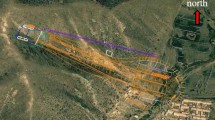Abstract
To explore the impact of seismic intensity on the working performance of ballasted track bed, the seismic acceleration corresponding to earthquakes of magnitude 6, 7, 8, and 9 is obtained through the method of artificial synthetic seismic wave, and the ground motion is added to the discrete element model of the ballasted track to realize loading. The synthetic method of seismic wave adopts the spectrum representation method of the simulation of an essentially non-stationary random process, in which the modulation function is the time–frequency modulation function, and the self-power spectrum is the Kanai–Tajimi spectrum. The feasibility of this method is verified by comparing the mean value, standard deviation and autocorrelation of the generated seismic motion with the target value. The discrete element method is used to establish the ballast bed model, and the reliability of the model is verified by lateral resistance and vertical stiffness. Based on the above research results, the seismic waves under four seismic intensities are added to the bottom wall of the discrete element model, and it is concluded that the seismic intensity has a significant impact on the working performance of the ballast bed. With the increase in the seismic intensity, the lateral and vertical displacement of the sleeper, the lateral and vertical stress of the track bed, and the displacement–velocity–acceleration value of the bottom ballast particles all increase; compared with the other three earthquake intensities, the dynamic impact of the magnitude 9 earthquake intensity is more significant; under different seismic intensities, the displacement, stress and dynamic characteristics of ballast increase with the increase in seismic action time.












Similar content being viewed by others
References
Shinozuka M (1971) Simulation of multivariate and multidimensional random processes. J Acoust Soc Am 49(1):357–368
Shinozuka M, Jan CM (1972) Digital simulation of random processes and its applications. J Sound Vib 25(1):111–128
Shinozuka M, Deodatis G (1991) Simulation of stochastic processes by spectral representation. Appl Mech Rev 44(4):191–204
Shinozuka M, Deodatis G (1996) Simulation of multi-dimensional Gaussian stochastic fields by spectral representation. Appl Mech Rev 49(1):29–53
Deodatis G, Shinozuka M (1989) Simulation of seismic ground motion using stochastic waves. J Eng Mech 115(12):2723–2737
Deodatis G (1996) Non-stationary stochastic vector processes: seismic ground motion applications. Probab Eng Mech 11:149–168
Yang JN (1972) Simulation of random envelope processes. J Sound Vib 21(1):73–85
Priestley MB (1965) Evolutionary spectra and non-stationary processes. J R Stat Soc B 27:204–237
Priestley MB (1967) Power spectral analysis of non-stationary random processes. J Sound Vib 6(1):86–97
Bycroft GN (1960) White noise representation of earthquakes. J Eng Mech Div 86(2):1–16
Kanai K (1975) Semi-empirical formula for the seismic characteristics of the ground. Bull Earthq Res Inst Univ Tokyo Japan 35(2):308–325
Tajimi H (1960) A statistical method of determining the maximum response of a structure during an earthquake. In: 2nd WCEE, Tokyo, Japan
Wang D, Yu FX, Kong F et al (2022) Simulation of fully non-stationary random processes using generalized harmonic wavelets. Mech Syst Signal Process 181:1–21
Admin M, Ang HS (1968) Non-stationary stochastic models of earthquake. J Eng Mech 94(2):1–5
Ohsaki Y (1979) On the significance of phase contents in earthquake ground motions. Earthq Eng Struct Dyn 7(5):427–439
Esmaeili M, Noghabi HH (2013) Investigating seismic behavior of ballast-ed railway track in earthquake excitation using finite-element model in three-dimensional space. J Transp Eng 139(7):697–708
Diana G (1989) Dynamic interactional of railway systems with large bridges. Veh Syst Dyn 18(1–3):71–106
Maragakis (1996) Full-scale resonance tests of a railway bridge. Building an International Community of Structural Engineering, ASCE, pp 183–190
Yan B, Pan WB, Liu S et al (2017) Research on seismic response of simply supported beam bridge-track system of 30t axle load heavy haul railway. Vib Shock 36(03):189–195
Yang CW, Tong XH, Wang D et al (2020) Shaking table test of dynamic response law of subgrade with ballast track under earthquake. Rock Soil Mech 41(07):2215–2223
Yu J, Jiang LZ, Zhou WB (2022) Study of the target earthquake-induced track irregularity spectrum under transverse random earthquakes. Int J Struct Stab Dyn 22(16):225
Takahashi R, Hayano K, Nakamura T et al (2019) Integrated risk of rail buckling in ballasted tracks at transition zones and its countermeasures. Soils Found 59(2):517–531
Guo YL, Shi C, Zhao CF et al (2022) Numerical analysis of train-track-subgrade dynamic performance with crumb rubber in ballast layer. Constr Build Mater 336:1–15
Guo YL, Zong L, Markine V et al (2021) Experimental and numerical study on lateral and longitudinal resistance of ballasted track with nailed sleeper. Int J Rail Transp 10(1):114–132
Jing GQ, Luo Q, Wang ZJ et al (2014) Micro-analysis of lateral ballast resistance of seismic characteristics. J Vibroengineering 16(1):533–544
Liang JW, Chaudhuri SR, Shinozuka M (2007) Simulation of non-stationary stochastic processes by spectral representation. J Eng Mech 133(6):616–627
Liu J, Zeng B, Wu LQ (2015) Spectral representation of non-stationary ground motion process simulation—random function method. J Vib Eng 28(03):411–417
Liu ZJ, Fang X (2013) Simulation of stochastic function-spectrum representation of stationary ground motion process. Vib Shock 32(24):6–10+37
Li J, Chen JB (2007) The number theoretical method in response analysis of nonlinear stochastic structures. Comput Mech 39(6):693–708
Zerva A (2009) Spatial variation of seismic ground motions: modeling and engineering application. CRC Press, New York
Clough RW, Penzien J (1975) Dynamics of structures. McGraw-Hill, New York
Cacciola P, Deodatis G (2011) A method for generating fully non-stationary and spectrum-compatible ground motion vector processes. Soil Dyn Earthq Eng 31:351–360
Liu ZJ, Liu ZH, Liu W (2017) Probability model and response spectrum fitting of completely non-stationary ground motion process. Vib Shock 36(02):32–38
National Standardization Administration of the State Administration of Market Supervision and Administration. China Seismic Intensity Scale, China Standards Press, Beijing, 2020
Chen XM, Chen N (2022) Research on the working performance of fouled ballast bed under the multi-scale effect. Proc Inst Mech Eng Part F J Rail Rapid Transit 236(10):1234–1241
Ngo TN, Indraratna B, Rujikiatkamjorn C (2017) Micromechanics-based investigation of fouled ballast using large-scale triaxial tests and discrete element modeling. J Geotech Geoenviron Eng 143(2):1–16
Ngo TN, Indraratna B, Rujikiatkamjorn C (2014) DEM simulation of the behaviour of geogrid stabilised ballast fouled with coal. Comput Geotech 55:224–231
Guo YL, Zhao CF, Markine V et al (2020) Calibration for discrete element modelling of railway ballast: a review. Transp Geotech 23:100341
Li LF, Liu WF, Ma M (2019) Research on the dynamic behaviour of the railway ballast assembly subject to the low loading condition based on a tridimensional DEM-FDM coupled approach. Constr Build Mater 218:135–149
Ministry of Railways of the P.R.C. (2008) Railway ballast, China Railway Publishing House Co, Ltd, Beijing
National Railway Administration (2017) Code for design of heavy duty railway. China Railway Press, Beijing
National Railway Administration (2017) Code for design of railway track. China Railway Press, Beijing
Itasca Consulting Group Inc. (2013) Particle flow code. Itasca, Minnesotam U.S.A
Ministry of Housing and Urban-Rural Development of the P.R.C. (2010) Code for seismic design of buildings. China Construction Industry Press, Beijing
Author information
Authors and Affiliations
Corresponding author
Ethics declarations
Conflict of interest
The authors declare that they have no known competing financial interests or personal relationships that could have appeared to influence the work reported in this paper.
Additional information
Publisher's Note
Springer Nature remains neutral with regard to jurisdictional claims in published maps and institutional affiliations.
Rights and permissions
Springer Nature or its licensor (e.g. a society or other partner) holds exclusive rights to this article under a publishing agreement with the author(s) or other rightsholder(s); author self-archiving of the accepted manuscript version of this article is solely governed by the terms of such publishing agreement and applicable law.
About this article
Cite this article
Chen, X., Deng, Y., Chen, N. et al. Study on the influence of seismic intensity on the mechanical properties of ballast bed based on discrete element method. Comp. Part. Mech. 11, 675–687 (2024). https://doi.org/10.1007/s40571-023-00646-2
Received:
Revised:
Accepted:
Published:
Issue Date:
DOI: https://doi.org/10.1007/s40571-023-00646-2




